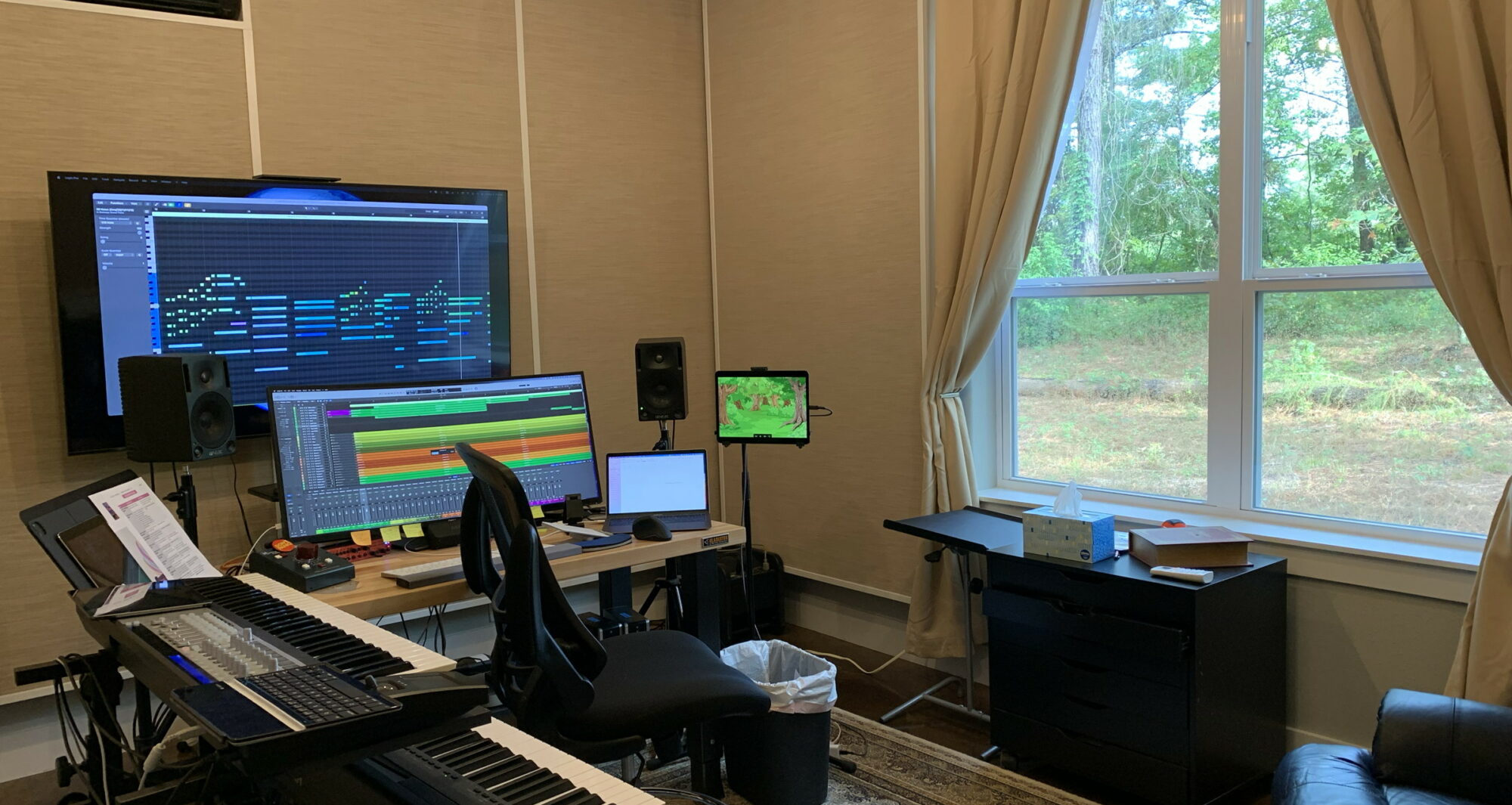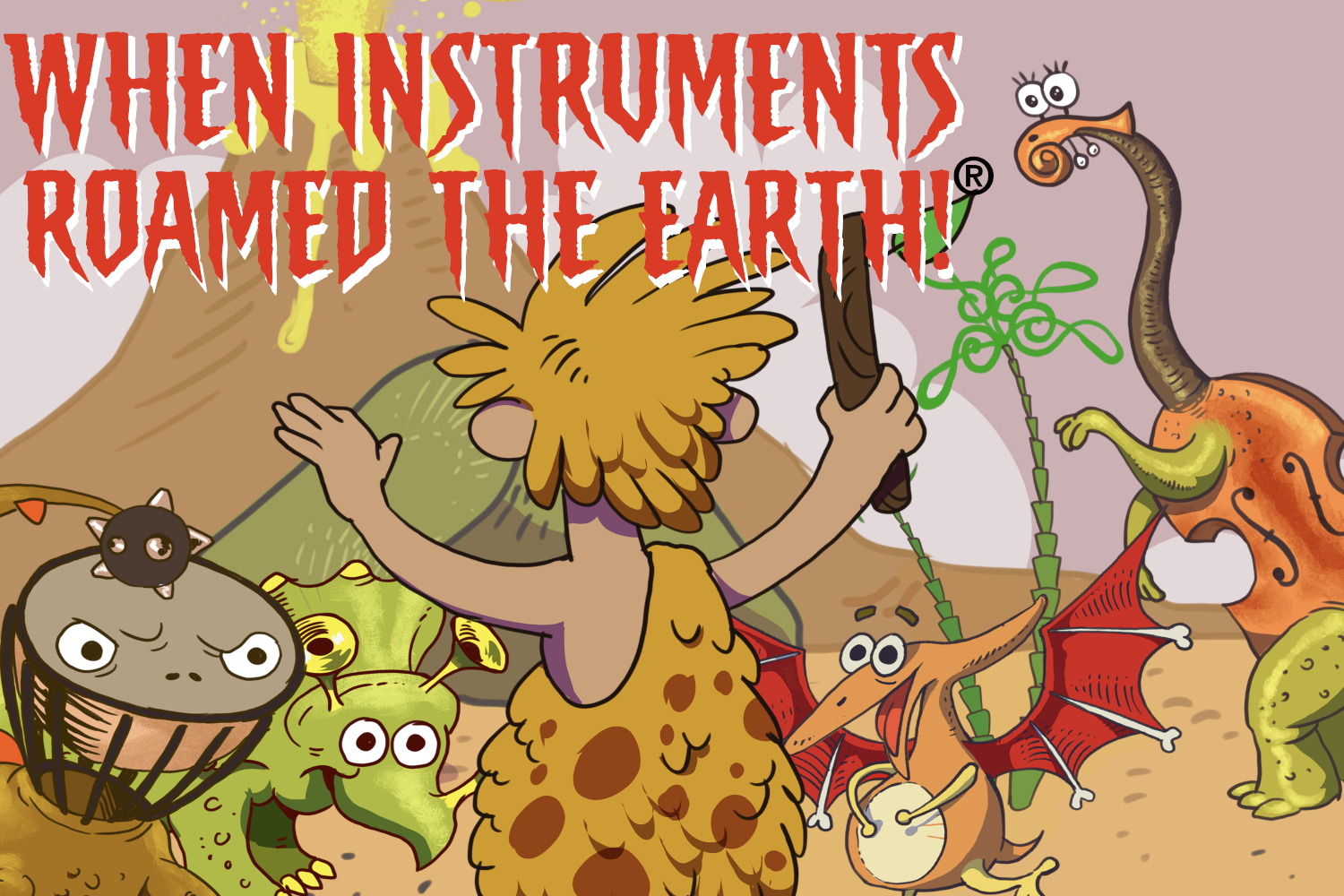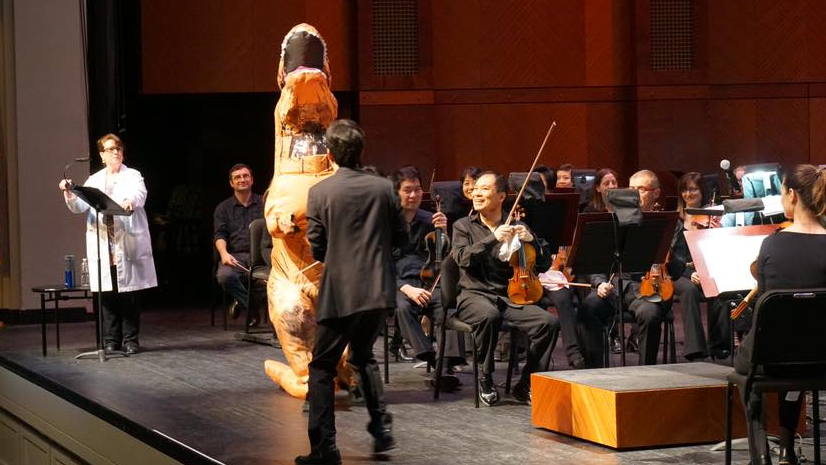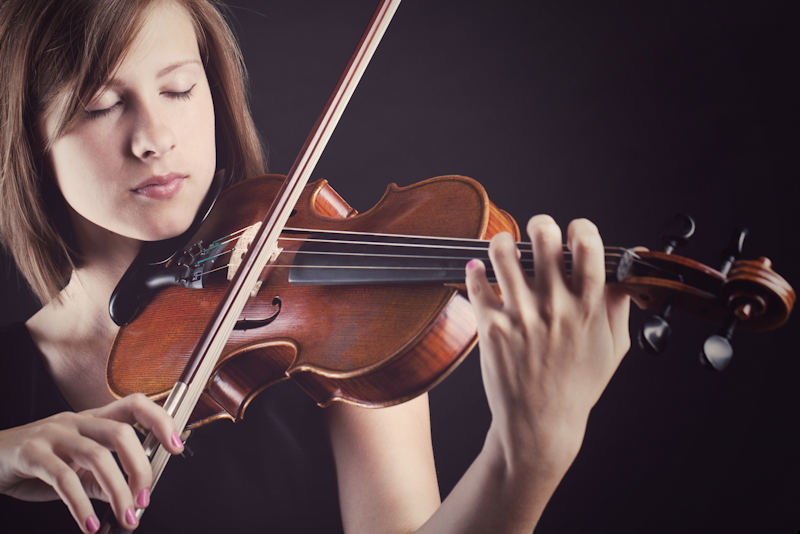Performed June 3, 2023 at the Meyerson Symphony Center, Dallas, Texas
“The Unicorn’s Birthday®” by Bob Singleton – Overview
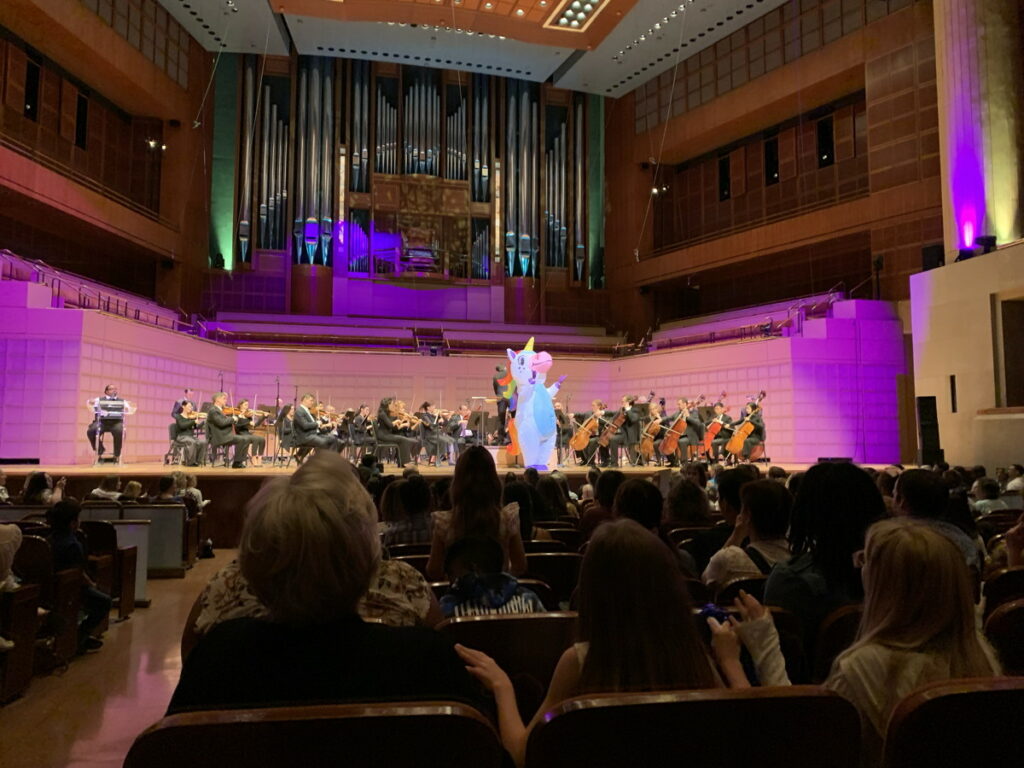
The Birthday Unicorn and the audience conduct the Dallas Symphony Orchestra in the rousing final movement of the concert.
“The Unicorn’s Birthday®” by Bob Singleton is a charming, fantasy-and-fun-filled symphony experience. Join the family-friendly birthday celebration brimming with music, narration, fun sounds, captivating on-stage activity, projection graphics, and gentle audience interactivity. This new work is an entertaining and welcoming concert for young families and/or special needs audiences. There’s even a visit from the costume-character Birthday Unicorn!
Hear, see, and imagine as the symphony orchestra presents a musical world of friendly penguins, monkeys, ducks, and other animals celebrating the Unicorn’s birthday. The concert finishes with a grand flourish as the audience conducts the symphony orchestra along with the costumed Unicorn. Everyone takes home free symphony-branded coloring pages filled with fun images from the concert.
Bring your favorite unicorn items, wear your best unicorn outfits, and get your picture with the Birthday Unicorn! The concert is perfect for patrons that are OK with moderate audience activity during the performance and wish to enjoy a memorable orchestra experience without frightening noises or musical tension.
The Unicorn’s Birthday was commissioned by the Dallas Symphony Orchestra, and co-commissioned by the Savannah Philharmonic Orchestra and the Oklahoma Modern Music Collective.
Bob Singleton, Composer – Bob is a classically-trained and Grammy®-nominated multi-platinum album award-winning composer & producer. He has also been nominated for 4 Dove awards in the Children’s Musical Album of the Year category. Bob is probably best known as music director for the hit kids PBS TV series and home videos, Barney®, and Friends for 10 years.
His works for symphony orchestra have been performed by the Dallas Symphony Orchestra, Nashville Symphony, Fort Worth Symphony Orchestra, Louisiana Philharmonic Orchestra, Alabama Symphony Orchestra, and many others.
“The music is catchy, clever, full of beautiful melodies, and peppered with entertaining sound effects like cats meowing, ducks quacking, and some simple spoken words or sound effects from the musicians. I was so pleased at the first rehearsal when the musicians were giggling and smiling throughout.
“I would highly suggest programming The Unicorn’s Birthday for a sensory-friendly and/or family concert! We will definitely be working with Bob again.” – Jennifer Guzmán, Director of Education, Dallas Symphony Orchestra
“I thought it was a wonderful program and definitely a keeper for future years. I was watching the audience and the interaction was fantastic, the length perfect, the melodies sweet and fun, and, of course, the orchestra “parts” hilarious. You cannot go wrong with Bob Singleton.” – Karen Schnackenberg, Principal Librarian, Dallas Symphony Orchestra
“It was such a pleasure to be part of this project!! I think this is a very special piece and I was proud to be part of the team that brought it to life. I hugely enjoyed working with Bob, and if there are opportunities to collaborate in the future, I would be eager to do so.” – Maurice Cohn, Conductor
“I wanted to let you know that I have been doing this for 20 years and I have never seen so much positivity about a children’s concert. The orchestra absolutely loved it! This was truly an amazing project and kudos to you for creating it!” – Bob Greer, Librarian, Dallas Symphony Orchestra
“First, you did a wonderful job of inviting a new audience into our world in a way that they could understand. Second, the music and the melodies were delightful! Third, The Unicorn’s Birthday is simply a first of its kind that I am aware of, a pioneering work for an audience as yet unreached.
“I am so proud to have been a part of the first performance!” – David Matthews – English Horn, Dallas Symphony Orchestra
“The Unicorn’s Birthday®” by Bob Singleton – Concert Information Summary
Performance Length: 45 Minutes
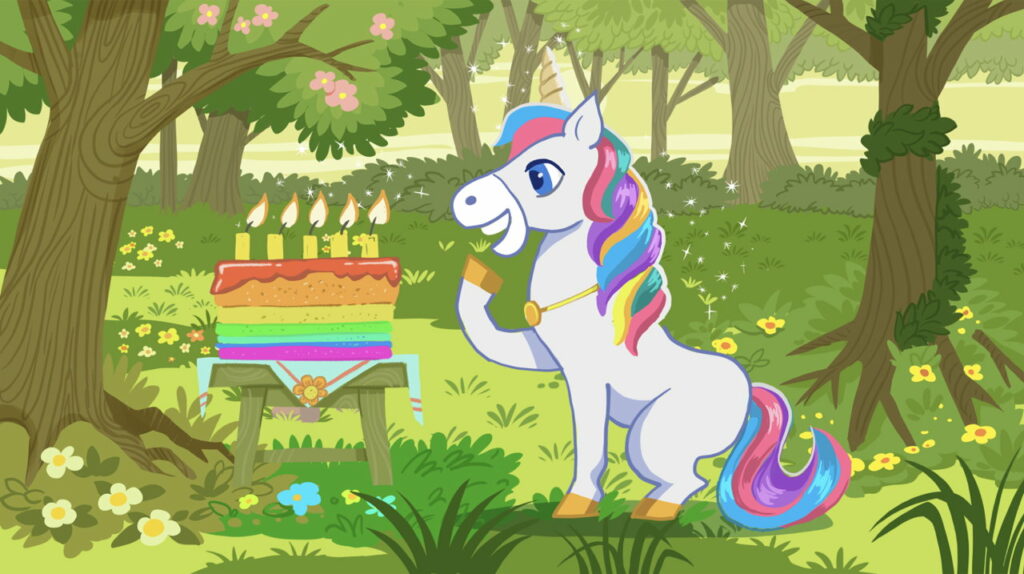
Presented by:
Medium-size double-winds orchestra (see instrumentation below)
Narrator
Inflatable costume character Unicorn (costume available on Amazon)
Special included features:
License allows unlimited performances for entire season
Tiered pricing
Streaming rights for one year
Adorable projection graphics (not required, but helpful)
Brand-able coloring pages for program or lobby activities
Promotional graphics and text
Can be presented as family and/or special needs/sensory-friendly
Delightful on-stage activity by musicians
Gentle audience interactivity
Music & narration never overlap
Three detailed scripts; Narrator, Technical, & Slide Advance
Instrumentation:
2 flutes
1 oboe
1 English Horn
1 Bb clarinet
1 Bb clarinet/bass clarinet
2 bassoons
3 French Horns (with mutes)
3 C trumpets (with straight mutes)
*optional Bb trumpet parts included*
3 trombones (with straight mutes)
3 perc.*
violins 1
violins 2
violas
cellos
contrabass
Note: no piano, harp, tuba, or timpani
*Percussion list:
snare drum (snares on & off)
Tuned percussion: glockenspiel & xylophone
Misc. percussion:
tambourine
wood blocks
finger cymbals
small crash cymbals
small suspended splash cymbal
triangle
ratchet
bell tree
duck call
engraving by Philip Rothman, NYC Music Services
Details, Details! about “When Instruments Roamed the Earth!®”
When Instruments Roamed the Earth!®
a family symphony orchestra concert
© 2021, Singleton Productions, Inc.
concert description
New for 2025! Second Edition scores & parts music engraved by NYC Music Services/Philip Rothman with updated scripts & educational download!
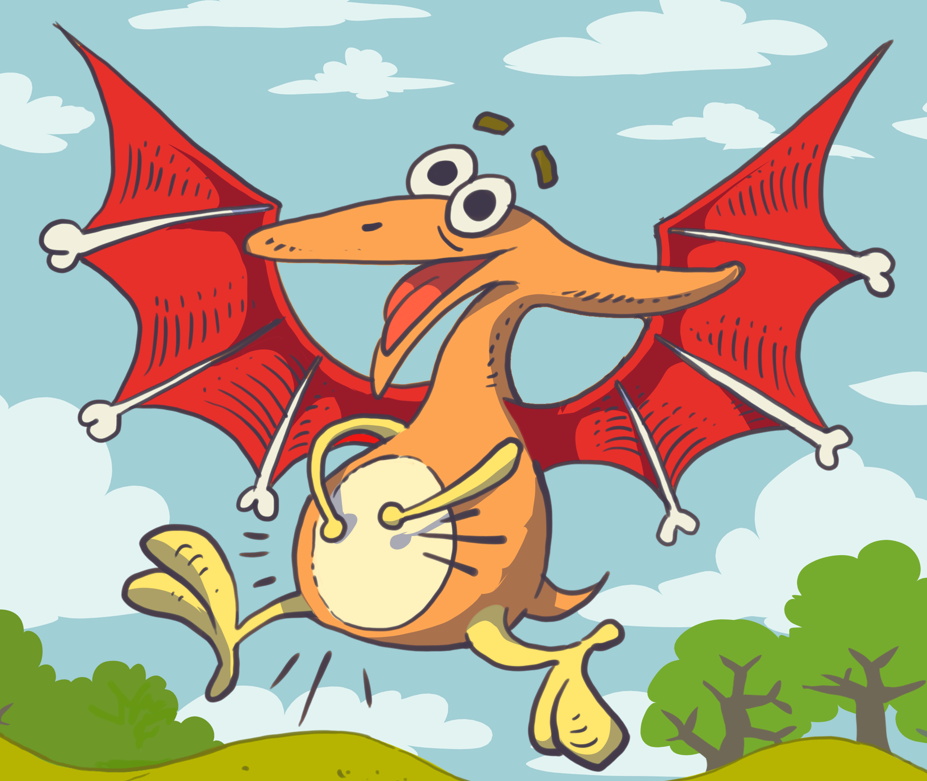
“When Instruments Roamed the Earth!®” is an all-original, multi-media, story with narration. and music event for symphony orchestras.
Just as Looney Tunes introduced a generation to loving classical music, “When Instruments Roamed the Earth!®” takes a new generation on a hilarious journey to love the people, the sound & the experience of the symphony orchestra.
“When Instruments Roamed the Earth!®” is sold as a “season pass,” allowing unlimited performances during a season.
The concert purchase package includes:
- .pdf conductor score, all parts books, narration and technical scripts
- all graphic files for projection during performance
- promotional graphics, video, and text copy for programs, print, and web media
- all rights to present music, story, & graphics in concert and promotions for 1 year
- printed scores and parts available, and are sold, not rented
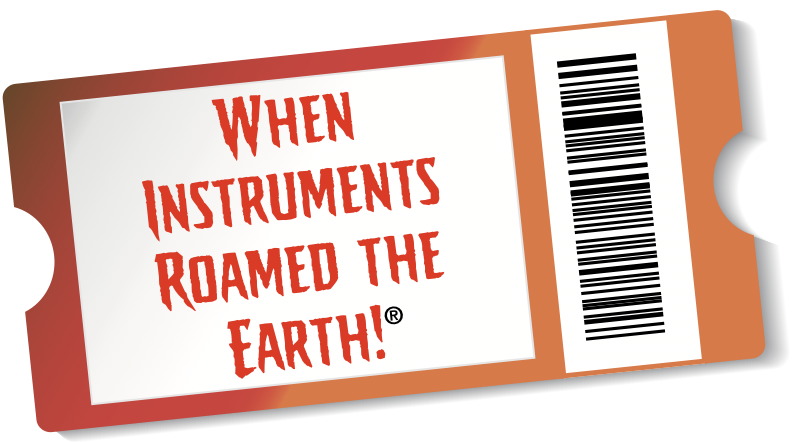
Specifications:
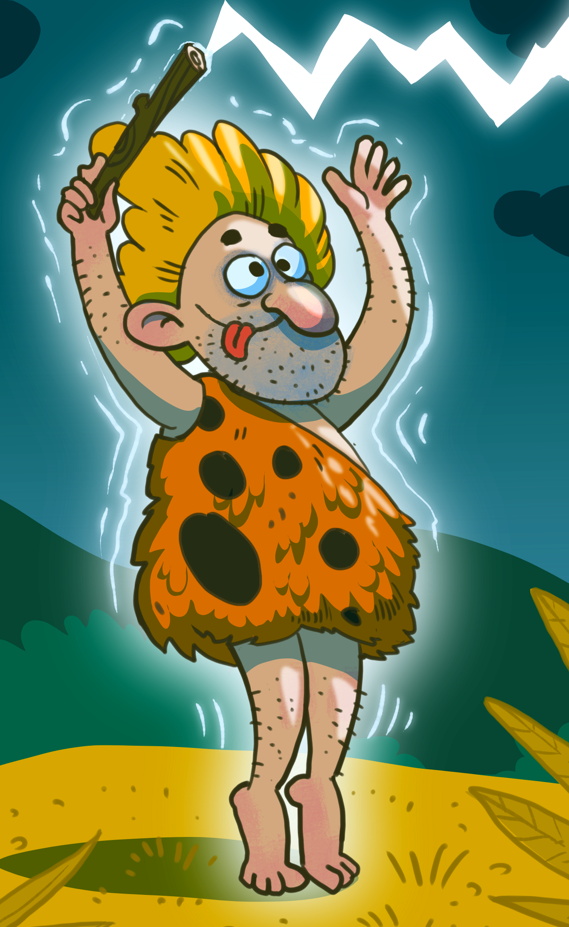
- perform in under 45 minutes
- “double winds” orchestra (plus piccolo-full orchestration listed below)
- all original score, graphics and story
- narration can be delivered by special guest or conductor
- fun & funny music and story for kids and grown-ups
- features orchestra soloists and sections throughout
- one easy rehearsal, many impressive performances
the concert
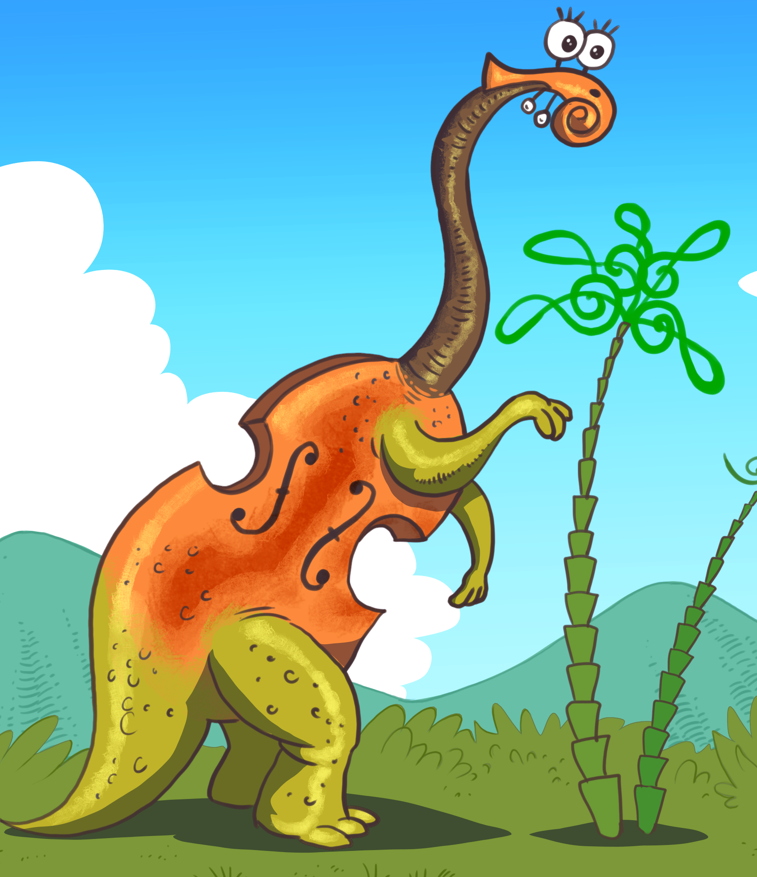
In pre-historic times, strange creatures walked the planet. These were the ancient ancestors of musical instruments that inspired melodious makers in brass and wood to create the instruments we see in the orchestra today.
Take a journey into, “When Instruments Roamed the Earth!®” Filled with laughs, surprises, multi-media projection and on-stage action, any symphony can easily present this perfect all-ages introduction to the exciting sounds, people, and experience of a symphony orchestra concert.
Hear and see the hilarious “research” of paleo-musicologist, Sir Humphrey Treble-Clef, who believes that our modern instruments are actually the descendants of giant, dinosaur-like creatures like you’ve never seen before. These are strange creatures which exist in the hot, mysterious, swampy jungles of Sir Humphrey’s unusual imagination.
Most will not believe a man who tried to prove that ancient humans made music by hitting themselves on the head with rocks; but everyone will smile, laugh, and be in awe of the symphonic interpretations of Sir Humphrey’s wild theories, featuring all the instruments of the symphony orchestra.
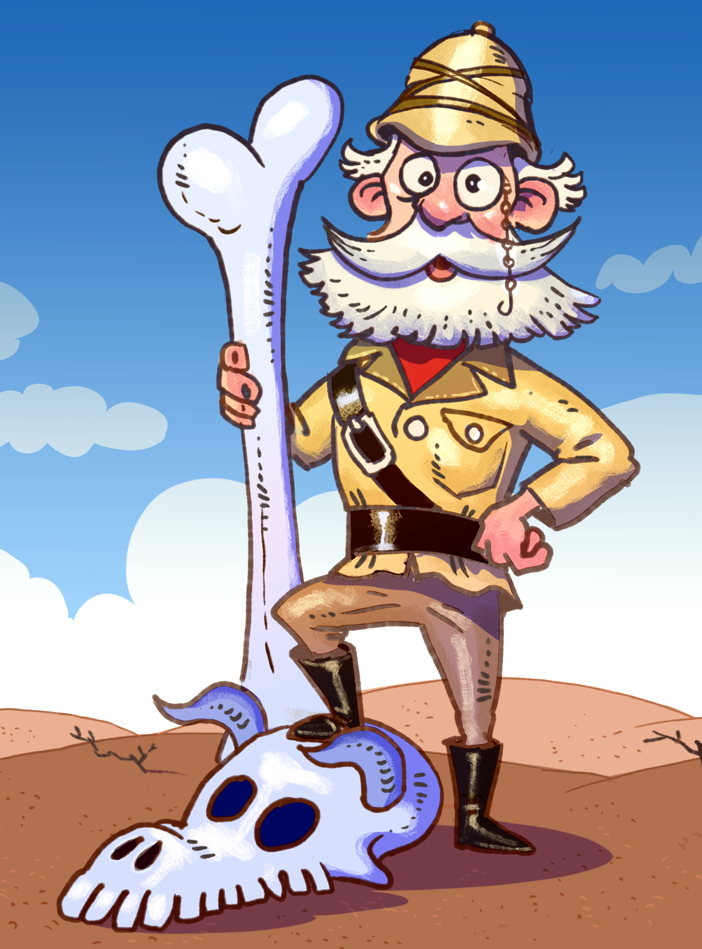
The concert event package includes:
- fun and funny musical sounds and sights
- liberal use of humor and energy
- a showcase of the people, instruments, and dynamics of the symphony orchestra
- a musical/narrative journey that builds to a grand finale, leaving audiences wanting more
- fun, eye-catching original art for projection, programs, print and social media
- fun, challenging, and performable music
- narration can be delivered by a hired performer, the conductor, or by a non-musical guest narrator
- social-media-friendly lobby interactions with characters, musicians, and sponsors
take away promotional & lobby activities
Symphony branded pdf coloring pages are included for lobby fun and take-home promotional items. Symphonies add their logo and/or sponsor logo on art that will live for months on bedroom walls and refrigerator doors.
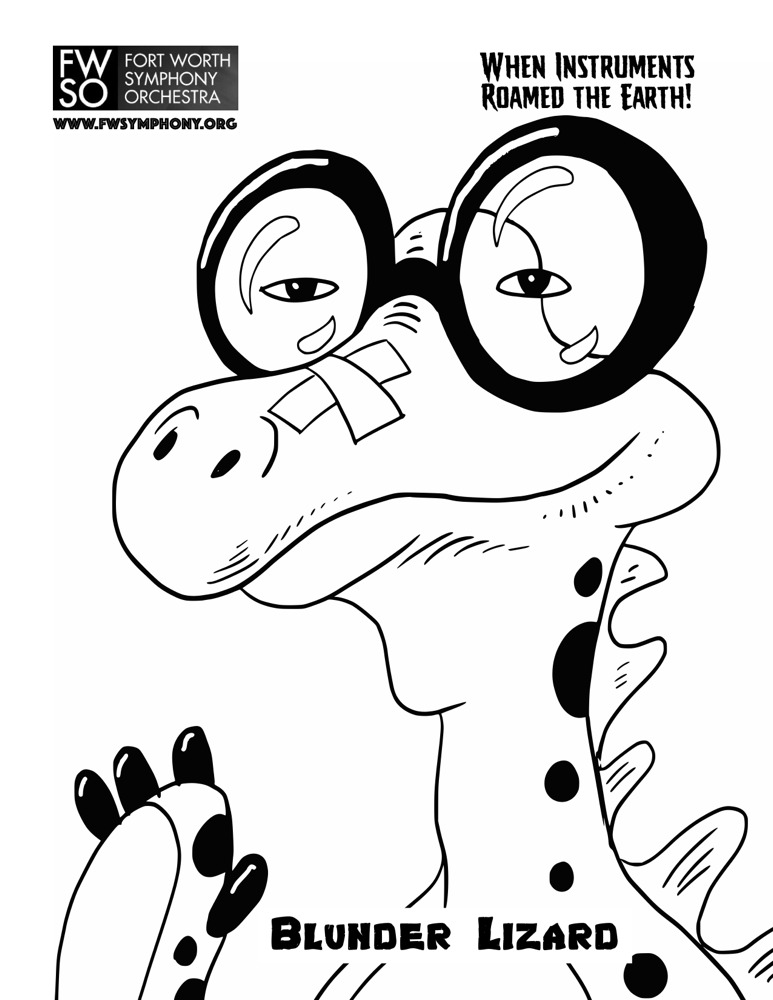
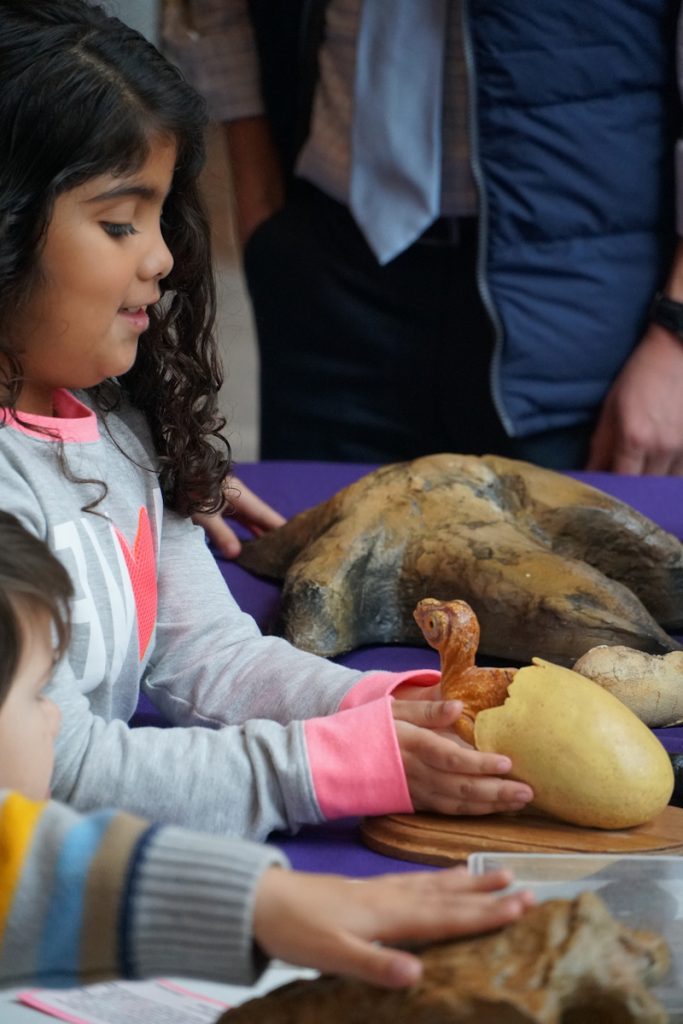
Create complementary lobby co-promotions with sponsors and natural history museums.
Lobby social photo opportunities spread the symphony name and fun by including onstage characters and symphony musicians.
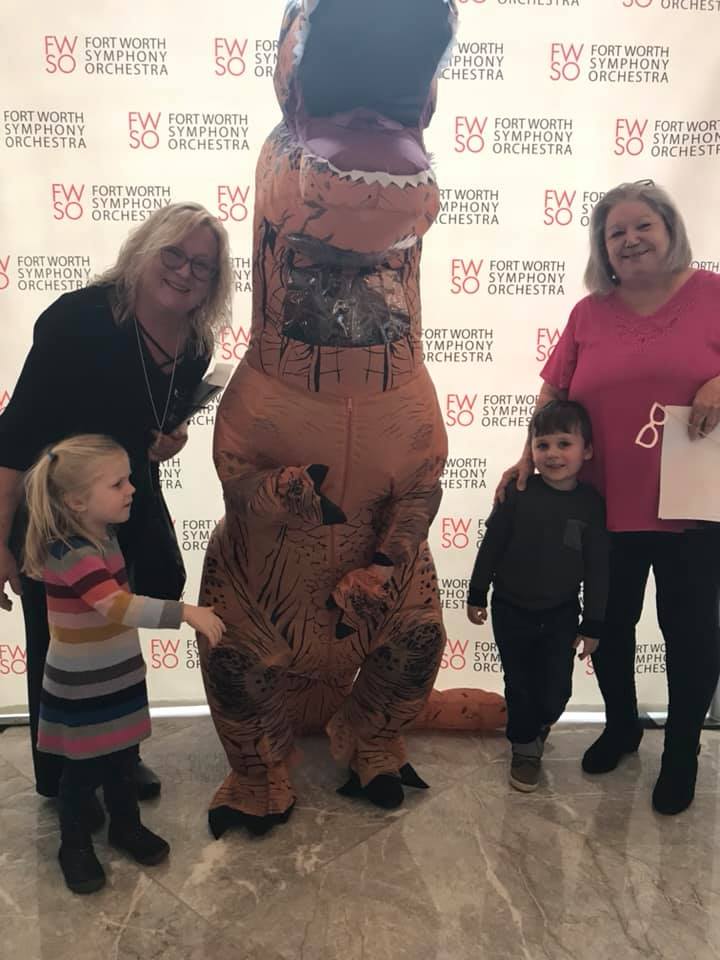
educational values
Families will be thrilled as they experience exciting, age-appropriate sights, sounds, and sensations with the orchestra, making them laugh and want more. Using captivating examples and without lecturing, audiences see, hear, and experience the four sections of the orchestra with eye-and-ear-catching examples by soloists and sections.
The performance uses visually kinetic “choreography” throughout as soloists and sections stand and interact, showcasing dynamics, contrasts, personalities, and the enchanting sounds of the orchestra.
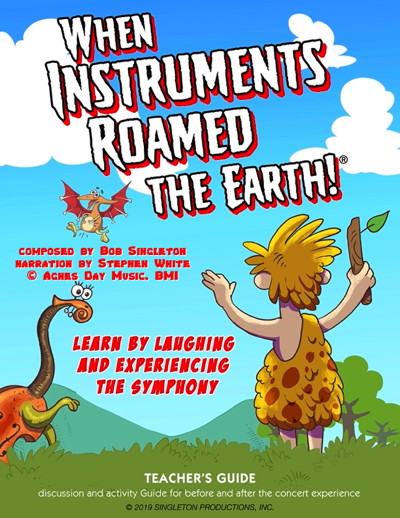
Includes free downloadable Teacher’s Guide with pre-concert and post-concert discussion ideas.
audience survey responses
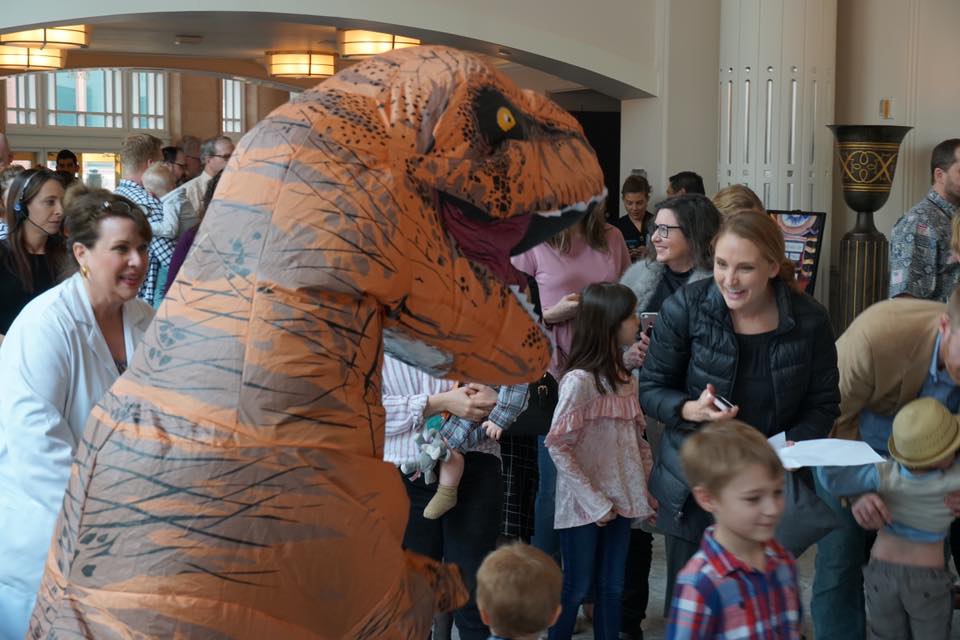
(survey of audience members at world premiere performance):
- “Best of the 3 [family] concerts we attended!”
- “Amazing! The children were so engaged and excited! FANtastic!!!”
- “If this is an example of what the family concert series is about, I’m sold.”
the creative team
“When Instruments Roamed the Earth!®” is created by the award-winning TV writing team of Bob Singleton, composer, and Stephen White, script & story.
Bob Singleton is a classically trained, Grammy®-nominated and multi-platinum album award-winning composer, producer, and arranger. His musical works for kids includes music for over 70 PBS episodes, more than 60 albums, an NBC network special, and a sold-out Radio City Music Hall run. Bob served as the music director for the world-wide children’s phenomenon, “Barney® & Friends” for 10 years, and has been awarded two multi-platinum albums, and nominated for a Grammy® and 4 Dove awards in the Children’s Musical Album of the Year category.
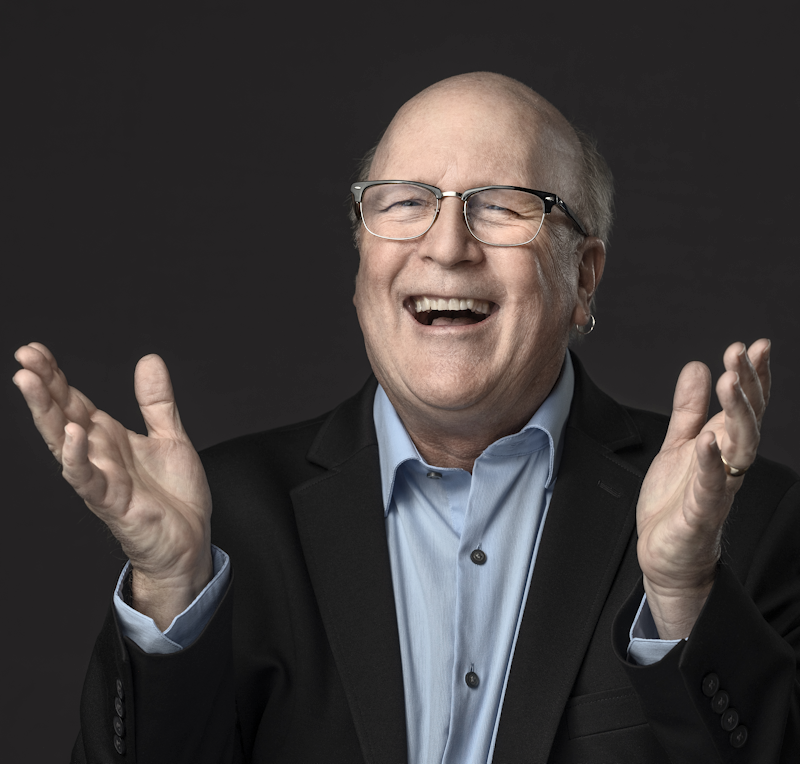
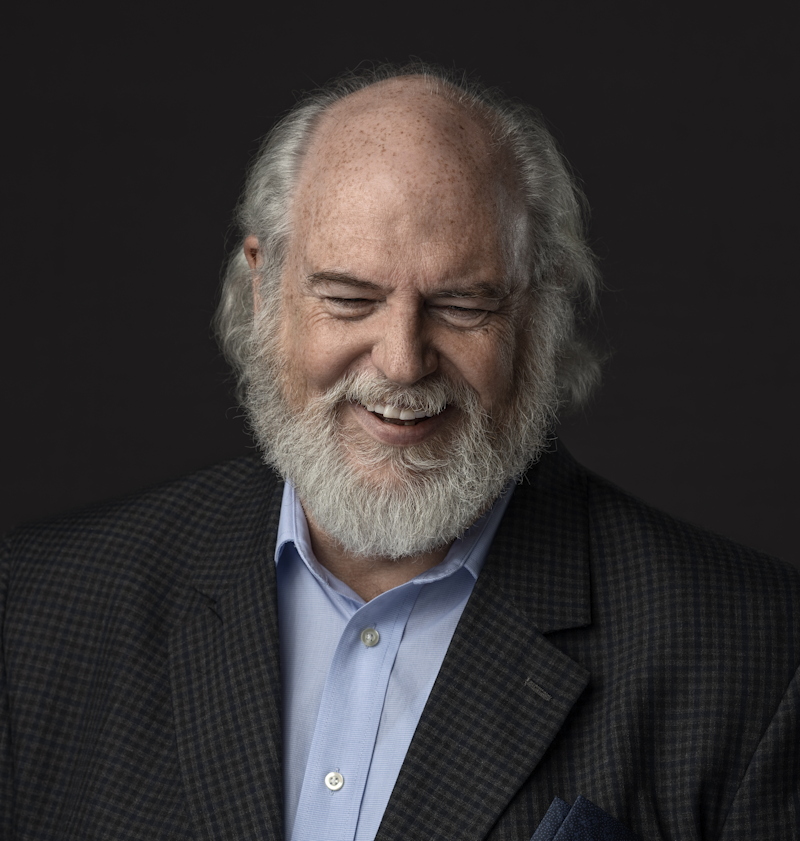
Stephen White is an Emmy and Grammy®-nominated writer, with years of experience writing for television, home videos, stage shows, million-selling children’s books, and film. His credits include Principle Writer for “Barney® & Friends” (16 years), writer for in-store musical extravaganzas for Chuck E. Cheese, lyricist for many award-winning songs and commercials, and children’s app developer/creator of “AlphaBELCH” and “Thumbpire,” which incorporate stories, images, and music for young children.
Max Larin is a busy artist and illustrator for books, magazines, and computer games around the world, while enjoying life in Kiev, Ukraine. He loves watercolor painting and creating imaginative worlds with computer tools.

orchestration
strings:
violins 1
violins 2
violas
violoncello
contrabass
woodwinds:
1 piccolo
2 flutes
2 oboes
2 Bb/A clarinets
2 bassoons
brass:
4 horns in F
3 trumpets
3 trombones
1 tuba
percussion:
1 timpani
3 utility
1 piano (can be digital)
1 harp
projection specifications
Projection content is 42 sequentially numbered 1280×960 pixel .png graphics files. These files must be placed into the projection program of your choice. There is a separate “Slide Advance Script” with cues and instructions. Slides only advance during narration, so operator does not need to read music.
audio specifications
2 voices need microphones: conductor & narrator (voices speak sequentially, never overlap)
Optimum mic/operator spec for voices:
- conductor – your choice of microphone
- narrator – wireless headset mic for narrator to allow gestures and possible entrances/exits
- audio operator to balance volume levels between conductor and narrator, plus mute inactive channels
Minimum mic/operator spec:
- one microphone shared by conductor & narrator, and handed off from conductor to narrator
- boom mic stand for narrator
- mic placement should allow narrator to gesture with hands, and have sightlines for script, orchestra, and graphics
- audio operator to adjust volume and mute mic when necessary
lighting specifications
Optimum lighting:
- full orchestra illumination during music cues
- fixed spot on narrator during narration
- one follow-spot with operator for T. Rex costume character
Suggested pre-programmed lighting looks:
- full orchestra lighting for all music cues
- narrator on side of stage with fixed spot and orchestra lights down, allowing visibility of projection on screen and drawing attention to narrator.
- for final music cue, manned follow spot on T. Rex plus full orchestra
Minimum Lighting:
- orchestra illumination with pre-lit narrator and conductor.
- allow enough down-stage spill to light the “guest conductor” in a T-Rex suit who will enter and position in front of conductor riser to do physical schtick during music Cue 10.
- anticipated area of T-Rex movements is up to 20 feet left and right of the conductor riser.
staging considerations
- One music stand for narrator script; placed on either stage left or right of orchestra, not at center. Short exit path off-stage or stepping out of sight for narrator is a plus during music cues. Narrator does not require a seat onstage.
- T-Rex suit is 7’ tall, and the tail is nearly 3 feet long. Person in T-Rex suit will have very limited visibility. They should have an area of sufficient size near the stage to put on and inflate the suit. It is recommended that there are no stairs or obstacles on path to stage.
- T-Rex should have a straight, unhindered path to front and center of stage from wings.
- A backstage and lobby event wrangler for the character should be provided.
- T-Rex character will need at least 6’ of space between orchestra and lip of stage, plus 20’ left and right of conductor riser to perform during final music cue.
post-concert meet & greet/social media stations in lobby
Pre-plan social photo stations with line wranglers and courtesy photo-takers for 2 characters. Any additional meet & greet such as conductor and musicians is a bonus.
When Instruments Roamed the Earth®! Composer’s Concert Notes & Music Cue Narrative Descriptions
music by Bob Singleton, narration by Stephen White
© 2019 Agnes Day Music, BMI. Used by Permission. All Rights Reserved.
NOTE: “stand/sit” instructions are NOT optional.
The Concert
The Objective
The objective of “When Instruments Roamed the Earth!®” is to present a kinetic, multi-media story-and-music concert event. Just as Looney Tunes introduced a generation to loving classical music, “When Instruments Roamed the Earth!®” takes a new generation on a hilarious journey to love the people, the sound & the experience of the symphony orchestra. It is a modern cartoon approach to inspiring the next generation of symphony lovers & musicians.
The Audience
The core audience for this concert is kids first, and their families second. The orchestra’s job is to create an extraordinary, kid-capturing multi-sensory experience with dynamic sights, sounds and sensations. The music is just part of the entire experience, and the music should be packed with dynamics and fun, and delivered with humor and activity. Once kids have their first “wow” symphony experience, they will be ready to explore the depth and range of the orchestra. They will be hooked.
They enjoy anything that is fun, and funny. They seek heroes. They connect with individuals. They are endlessly curious. They want to see and experience. They don’t want you to explain to them, they want to discover for themselves. And, they want to laugh. They really want to laugh, a lot.
The Presentation
Kids require a multi-sensory experience. They access information using all their senses, and experience life with all senses, simultaneously. Boldly present visuals, seat-shaking sensations, and the full dynamics and textures of the orchestra. It’s difficult to go too far for most kids with all the senses. Let them see and connect to you, the musicians, and their instruments. Give them lots of “in-the-seat” opportunities to interact, with applause, cheers, rhythm, and laughter.
This concert should be free of rules, and full of stimulus. It will be kinetic and dynamic; visually, aurally, and experientially. It won’t be a dramatic arch of theme, development, and long periods of repose. It will be a series of heroic moments with people, images, sounds and humor.
It’s imperative to engage kids in fun and laughter. Laughter is a visceral, whole-body bonding experience for kids. Ignore belly-laughs and fun with kids this age at your peril.
Igor Stravinsky is credited with saying, “I haven’t understood a bar of music in my life, but I have felt it.” Kids are the same. Let kids feel the experience. Don’t explain it to them.
The Payoff
Enjoy. Embrace the way kids enjoy the experience. Have fun. It shows, and kids can read it. Wow them with this concert, and then take them on a rich, music-filled life-journey with the people and music of the orchestra.
Bob Singleton, composer
Dallas, Texas, USA
2019
Composer’s Concert Notes & Music Cue Narrative Descriptions
Q01 “When Instruments Roamed the Earth! Theme”
This cue is an exercise in comic musical pomposity.
Measures 1-11 are reminiscent of 1950’s era science-fiction movie themes for famous black and white movie Japanese monsters. The exuberant, over-the-top tension and noisy dynamics are designed to grab the attention of kids and entertain adults.
Measures 12-20 is a grand fanfare heralding the comic self-importance of the concert, foreshadowing the pomposity and ignorance of the main character, Sir Humphrey Treble-Clef.
Measures 21 to the end is the march theme. Think of it as a theme to “Raiders of the Lost Ark,” if that movie was a slap-stick comedy. This is a continuation of the silly self-importance of the main character, echoing the background music used in cartoons and black and white newsreel footage of famous explorers and national heroes.
Q02 “Sir Humphrey Treble-Clef”
Sir Humphrey is a silly character, who probably achieved his title of “sir” by accident or misunderstanding. When he was a child, his curiosity led him to look at ants through a magnifying glass, whereupon he accidentally set them on fire by focusing the sun on them. He has probably mixed up “right” and “left” all his life and never noticed.
As an adult, his most academic pursuits have been comic books and alien conspiracy theories. The music reflects this character that is oddly out-of-step with the rest of the world, with an off-kilter world view that is funny to everybody besides himself. If it was brought to his attention, he wouldn’t get the joke.
The comic interplay of the flutes, piccolo, and bassoon in mm. 12, 21, and 55-56 reflect his comic character, as does the general musical foolishness and whimsy throughout this cue. There are 1/2 step melodic collisions in the main theme to emphasize Sir Humphrey’s looney personality.
Q03 “Kaboom for Orchestra”
“Kaboom for Orchestra” is a musical depiction of a cartoon archeological site. While nobody in their right mind would use dynamite while unearthing artifacts, Sir Humphrey Treble-Clef has never actually been in his right mind.
The cue starts with a match sonically being struck by the cymbal scrape in m. 1, the fuse being lit and burning with the strings and woodwinds trill in mm. 2-6, the explosion on the downbeat of m. 8, and debris falling depicted by the xylophone in m. 8 b. 3-4.
The general “busy-ness” and hubbub of the archeological site starts at measure 9. The 8th note activity theme in m. 9 is punctuated by more explosions (mm. 19-24, 33-34, 47) a hammer and chisel (m. 37-38, 48-49, 52-53), and using a scrub brush (m. 56-62).
Measure 55 to the end is the lazy end to a long day, with an “Oh, no!” ending. A match is lit by Sir Humphrey at m. 55 with the cymbal scrape, but it seems to go out. At m. 62, we find the fuse is actually lit (violins trill-trombone flutter tongue); while at m. 63, Sir Humphrey gets close to the dynamite, lights a match and tries to light the burning fuse again. A pregnant fermata-silence ensues.
In classic Roadrunner-vs. Wile E. Coyote fashion, after the pregnant pause, the dynamite explodes in m. 64, b. 3. It should be a shock to the audience.
Q04 “String Dinosaurs”
The string sections should be prepared to stand and hold up their instruments or gesture toward their instruments, when cued by the narrator during the talk before this cue.
This cue is a showcase for the strings. It purposely features techniques that are unique to the strings. Standing to show off the techniques allows kids to make a visual and aural connection to things they’ve heard, but may not know how they are created.
This cue starts with a moody, morning-in-the-mist feel, with a lush, amorphous pad-like sound from the woodwinds, strings, and harp. The violin solo depicts a small, lithe dinosaur waking, and stretching in the early morning light and mist.
Measure 19 transitions to the busy life during the day, with the forceful theme by the cellos, double bass, and piano. The aggressive theme is played by the 1st violins. The 2nd violins enter and antiphonally play the theme, demonstrating that there is more than one thing going on in that part of the orchestra, where everybody looks like they are doing the same thing.
The cue demonstrates pizzicato, sul tasto, col legno, marcato, solo and tutti playing. Everything should be played to its maximum effect; the beautiful pads should be lush and the solo should be expressive; the aggressive sections should be marked and punctuated. Players should put their body into their instruments and their parts so that kids will see that playing is not just an intellectual exercise, it’s a mind-soul-body experience.
The cue ends as it began, when the small dinosaur settles down at the end of the day, and with a final punctuation, drops into sleep.
Q05 “Toot Suite for Woodwinds”
The woodwinds should be prepared to stand and hold up their instruments when cued by the narrator during the talk before this cue.
This is a musical section about passing wind. Farting. A booty blast. A panty burp… tastefully presented by the symphony orchestra. If Mozart could refer to it shamelessly, it can be presented to bring laughter to everyone.
This cue presents the image of a chewing dinosaur with the sound of a ratchet and the passing of wind by the third trombone. The humor is enhanced by the dynamic contrast of the light and lyrical passages played by the woodwinds, and the wet, blatty, forte blasts by the third trombone. Extend the “fart” moments for comic effect, if you wish.
By m. 97, our dinosaur hero is feasting on the wind-inducing fauna with wild abandon, as the orchestra plays a sort of loud, drunken waltz. There’s one more big windy release at m. 111, and at mm. 116-117, a comic pause for effect, and then a non-tonal squeak of a singing release by the trumpet buzzing into a mouth-piece.
This will probably be the most memorable and talked-about piece of the whole concert. Embrace the fun.
Q06 “Horns Aplenty”
Brass should be prepared to stand and hold up their instruments when cued by the narrator during the talk before this cue.
This cue is a brass feature. It depicts what starts as a small gathering of “horned” dinosaurs and develops into a “traffic jam” of pushing and blaring by the end.
It showcases horn choir and horn rips, trumpet mutes, trombone slides, and each section with idiomatic themes.
Q07 “Blunder Lizards”
Percussionists should be prepared to strike their instruments when cued by the narrator during the talk before this cue.
This cue is a percussion feature. The percussion should be loud, and their gestures should be bigger than life.
This cue could be subtitled, “Fanfare for a Clumsy Dinosaur.” The narrator’s description is of large, slow, plodding, near-sighted, stumbling behemoths.
The big brassy fanfare and percussion is countered by light, flighty woodwinds, which could be imagined to be smaller, tinier dinos, butterflies, flying raptors, and flying debris that is stirred up by the large reptilian land masses.
Give this your best Olympic-style comic attention.
Q08 “Finale, Part 1”
This is a recap of several previous cues. It should be played with wild abandon.
At the end, the snare continues rolling under narration into the short next cue.
Q09 (only 4 measures) “Cymbalsaurus”
Tension builds as the narrator, over the rolling snare, describes that there is a meteor, hurtling toward Earth. It’s comically revealed that it wasn’t a huge meteor, just a little tiny one that crashed on the head of the Cymbalsaurus.
Q10 “Finale Finish”
There will be an inflatable T-Rex costume character on stage. The audience will go wild. This cue should be played with wild abandon for comic effect while the T-Rex “conducts” the orchestra. Everything is accented and forte, sounding like at every turn, it might finally end. It doesn’t.
There are 3 big, false endings where it sounds like it really might end: mm. 11-12, 25-26, and 43-45.
Shout the text mm. 39 to the end like you’re a cheerleader. Don’t be shy.
***end***
The Unicorn’s Birthday® general concert notes, & specific movements notes for conductors and musicians
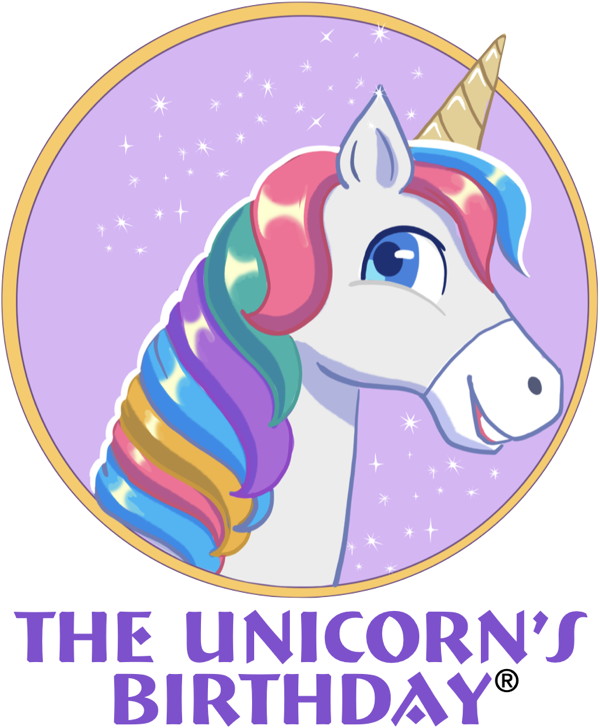
music & story by Bob Singleton
“The Unicorn’s Birthday®” is a gentle, fantasy-and-fun-filled symphony experience with engaging music, fun sounds, captivating on-stage activity, friendly graphics, and gentle audience interactivity. The audience will fall in love with the people, the sound, and the experience of the symphony orchestra.
General concert notes
the audience
This concert is designed from the ground up to be a musically-satisfying and welcoming concert for families with small children and special needs audiences. This audience can include parents with a preschool child, individuals with autism who are significantly impacted by various sounds and need noise-cancelling headphones, individuals with Down syndrome, or patients with dementia and their caretakers.
It is perfect for patrons that are OK with moderate audience activity during the performance and wish to enjoy a memorable orchestra experience without sudden, loud noises or musical tension.
The guiding principle is to connect to a difficult-to-reach audience, in mind, soul, and body. This is much different from concerts where the orchestra invites the audience to visit a world with them; whether it’s Berlioz’s drug-addled visions, or Ravel’s lush mythic soundscapes, Mozart’s courtly Vienna, or funky Detroit-beat Motown.
This audience gives the orchestra permission to visit THEIR world. The outside world is not very safe for them. The orchestra has to establish that they are friendly and are not going to “break the furniture” with shocking sounds or perceived threats.
That requires making everything as gentle and friendly as possible, so the audience can drop their guard and experience the music and the moment without fear.
The audience will be full of people who have never seen a live symphony orchestra. They have frightening questions like, “When do I clap?” “Who is that person with a stick, and what are they doing? Are they angry? Are they going to hit someone?” “Who is that mob of black-garbed people on the stage? Are they safe?” and, “What made that sound?”
This is an audience that fears they will get the rituals and ceremonies wrong, get laughed at, get “shushed,” or anger people because they clap, laugh, or make noise at the wrong moment.
the music
To accommodate this audience, I’ve chosen to forego the usual toolbox of musical dynamics. There are no harmonically or rhythmically tense “Jaws Theme” moments, no bombastic percussion or fortissimo blasting brass, no screeching piccolos or chair-rattling timpani.
I still have to create compelling music even without the usual musical dynamics. Composing is about creating tension, and then resolving that tension, but I can’t use the typical musical extremes of tension and resolution. I have to take the audience to expected places, with familiar melodic shapes, phrasing, and forms, to connect with the audience.
That means the dynamics are in the live staging, graphics, audience interaction, and fun sounds. Ducks quack, crows caw, cats meow, and the audience gets to use gross motor skills to flap imaginary wings, pose like a dancer, make sounds, and “conduct” the orchestra.
the orchestra
The orchestra is the star of this concert. There is narration, graphics, and a costumed character, but the orchestra performs for 2/3 of the time in the concert. When the orchestra plays, they are the focus of attention. People will leave talking much about the orchestra and little about the narration or costumed character.
The stand/sit instructions and action notes are not optional. They are critical to the performance. They cause the audience’s attention and connection to skyrocket. The orchestra becomes people, individuals with humor. They are both inspirational and aspirational.
The musicians must take the small personal risk to stand and play, have fun, and break the wall of the front row of musicians in the orchestra. The orchestra should be a collection of fun-loving individuals with personalities and a willingness to connect with the audience.
Trust me: There is no audience that will respond more warmly or appreciate you and your talent more.
Have fun. Embrace the activity. Love your audience. Extend joy. The audience will return the love and joy back to you.
Bob Singleton, composer
March 2023
===================
Concert summary
Premise: It’s a birthday party for the unicorn, and everyone’s invited!
A narrator invites everyone to a birthday party in an enchanted forest, where various groups of friendly, imaginary animals present dances for the guest of honor, the birthday unicorn. Where possible, graphics are projected during narration, or a coloring book/program is given away, and coloring pages are a pre-concert lobby activity.
The concert is a fable story and musical suite of 11 movements presented with alternating brief narratives and short, evocative musical movements, lasting a total of around 45 minutes. Most movements are presented as the accompaniment for various imaginary groups of friendly animals to perform dances they have prepared for the party. There are several opportunities throughout the concert for the audience to participate with simple motions imitating imaginary animals.
The “magical” unicorn remains invisible until the 11th and final movement when they appear onstage as a costumed character and ask the audience to help them “conduct” the orchestra.
It is suggested for sensory-sensitive audiences that hand-waving (“jazz hands”) substitutes for applause throughout the concert. The orchestra should wave back at the audience after each movement.
Larger instruments like bass clarinet and bassoons should bring neck straps for the times when they are standing and playing.
===================
Performance order and notes
pre-concert orchestra and conductor entry, tuning:
The typical symphony concert opening ceremonies should be completely dispensed with. All musicians, including the concertmaster and conductor, should informally enter the stage in a leisurely manner. The conductor can be anywhere they choose to be on stage, blending in with the musicians. Musicians can warm up and freely chat with each other if they choose. Tuning should be done discreetly and informally. When all is ready, the conductor should step onto the podium and deliver the welcome, without expecting the audience to quiet down to silence.
01 “The Birthday Fanfare” (an overture)
This movement welcomes the audience gently and musically to the concert by starting out quietly and building moderately. It allows the audience to get used to the presence and volume of the symphony. The audience is introduced to musicians standing and sitting, breaking the front wall of players, and allowing the audience clearly see what instruments are making the sounds.
The narrator enters the stage after this movement and introduces each movement with a brief description of the imaginary characters and their actions.
02 Party in the Woods
A pleasant mid-tempo musical exposition of how a unicorn’s birthday might sound. A shortened version of this movement is reprised as the final movement.
03 The Ponies Promenade
A dignified march, with percussion making clip-clopping hooves sounds. The audience is invited to mimic prancing horses.
04 The Jumping Joker Monkeys
This is the most energized movement of the entire concert. This sounds like circus music.
05 The Crows Choir
Everyone gets to channel their inner crow and say, “Caw!” The humor comes from the juxtaposition of the dreamy, melodic score with the loud, raucous “caws” coming from the orchestra. It’s important to stand and deliver your “caw” with personality. It doesn’t have to be absolute metric precision delivery on your caws, but feel free to vary the character. Do high, do low, do questioning – have fun.
Again, standing is critical. For some audience members, if they can’t see where the sounds come from, they are frightened. For others, it’s a chance to see what the rest of the orchestra looks like.
Have fun! It’s contagious!
06 Parade of the Penguins
This is a fun, gentle march movement that musically describes a scene with precision-marching penguins. The audience is encouraged to simply mimic marching penguins. Marching penguins – what could be cuter than that? Have some cute fun with this.
07 The Plucky Porcupines
This presents more fun with marches and vocalizations in this movement. The orchestra gets to say “ouch” in singles and groups throughout, indicating that they have been poked by a porcupine. The “ouch” sounds should be loud enough to be easily heard over the orchestra for the comic effect, but should never be overly painful-sounding. Make it sound like you’re being pushed, but not stabbed.
The ouches are very metrical in this movement. Be sure to perform them when and where indicated, adding lots of fun personality.
08 The Kittens Chorus
This is a movement with “mewing” kittens. The “mew” sounds will come from the 2 Bb clarinets. They must remove their mouthpieces, blow in them to make a gentle squeak, and move their index finger in and out to get a high-pitched “mew” like sound. The mews should only be downward, squeaking the mouthpiece while withdrawing the index finger.
The clarinet players remain standing throughout the movement and have action instructions to mimic kittens by preening and waving their paws slowly at each other in a lazy fashion.
The humor comes from the juxtaposition of thick, romantic melodies and harmonies with small, vulnerable, untuned “mews.” Audiences love this movement.
09 The Bears Ballet
This is a bass clarinet feature. The bass clarinet should use a neck strap to stand for this movement. The premise of the action in this movement is that bears can’t really dance. They can only slowly walk into place, and briefly hold a ballet pose or position. The “pose” moments are cued with the bell tree while the orchestra holds a chord.
If the conductor and members of the orchestra are so moved and are not otherwise engaged, they can stand and strike a pose during those moments as an encouragement to the audience to participate.
10 Waltz of the Ducks
There are noisy ducks in the orchestra! The English Horn and both bassoons plus a percussionist with a duck call will quack/honk like ducks and geese in several places, with the double reeds using multiphonics. The orchestra’s job is to play the waltz as a serious concert waltz so that the crazy honking stands in stark contrast.
11 The Birthday Finale
This is the big pay-off. It is a shortened reprise of the 2nd movement, “Party in the Woods.” The costumed character unicorn will come on stage and will “conduct” the orchestra along with the audience. The conductor will remain on the podium to conduct and hold everything together.
This should be bright and lively but should maintain the narrowed dynamics of the rest of the concert.
Bows & exit
Bows should be as abbreviated as possible. Move quickly to meet & greet in the lobby with all available personnel, including musicians, conductor, narrator, and unicorn costumed character.
********end********
The Fort Worth Symphony Orchestra, the commissioning orchestra, talks about the world premiere of “When Instruments Roamed the Earth!®” (formerly “Jurassic Parts”)
short professional observations by the people who presented it
There are a lot of moving parts associated with any symphony performance. These key professionals answered 2 questions:
- What would you tell someone in your role at another symphony organization about “When Instruments Roamed the Earth!®” (formerly known as “Jurassic Parts” at the world premiere)
- What would you tell a family friend who is considering attending the concert?
“When Instruments Roamed the Earth!®” (formerly “Jurassic Parts”) – An Original FWSO Family Series Performance
Musicians of the Fort Worth Symphony Orchestra newsletter
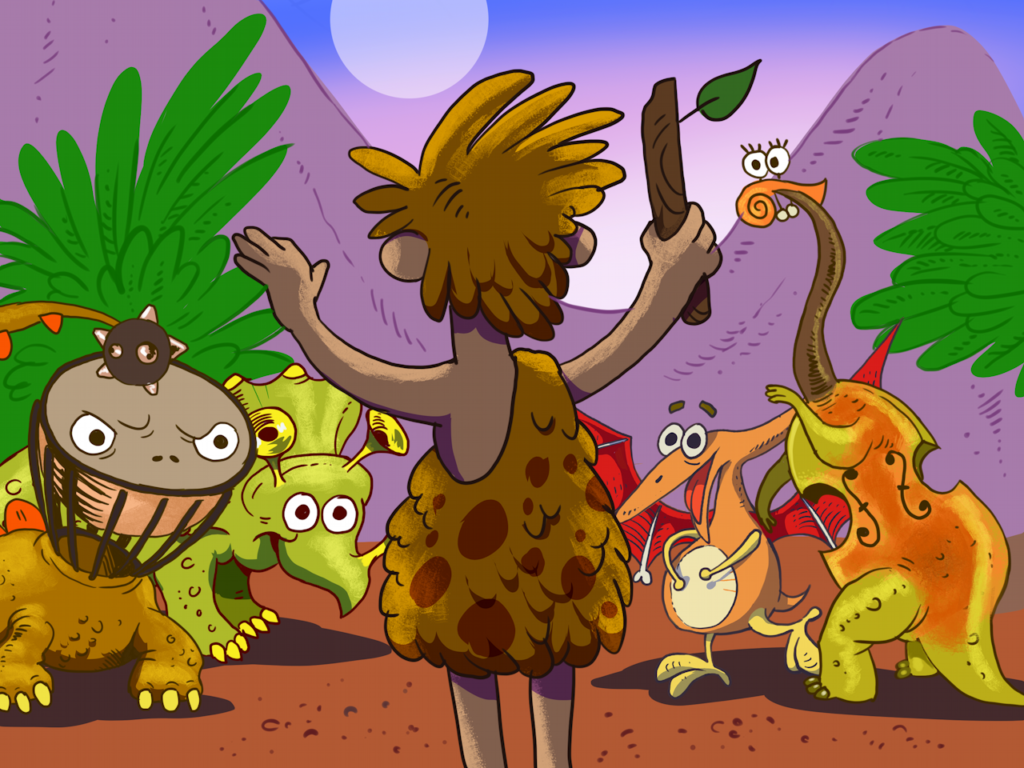
Interview by Tanya Smith, violin FWSO, as it appeared in the January, 2019 edition of the newsletter for Musicians of the Fort Worth Symphony Orchestra (link to original newsletter)
At the beginning of February, the FWSO will give the world premiere of the piece, “Jurassic Parts,” as the last installment of the Family Series concerts. It is written by local Grammy-award nominated composer Bob Singleton, whose music you may have heard on Barney the Dinosaur® as he was the music director for that series for ten years. It has nothing to do with the scary “Jurassic Park” movies and is instead a hilarious romp through the orchestra through means of some musical dinosaurs. Bob was kind enough to answer some questions I had about the piece. We hope to see you and all the children you know at the performance!
Tickets and more information about this concert can be found here.
How did this piece come about?
I have the most fun in life creating music. Creating music for kids ramps up the fun and the difficulties at the same time. Kids are brilliant, complicated, inquisitive, and have no pretense. It’s extremely challenging, and extremely gratifying when it works.
It was a natural thing for me to want to create something for kids and the symphony, and the idea of what that would look like has been bouncing around in my head for years. The challenge is huge to make something that kids will think is “lit,” and that my symphony friends will appreciate and enjoy performing.
Did you come up with the story?
My writer-collaborator for the story and narration is my good friend, Steve White. Steve is an Emmy-nominated writer who I met while we worked together on Barney the Dinosaur. He has an incredible kid-sensibility, and is one of the funniest people I’ve ever known. He carried the load on the story. He and I had several brain-storming sessions over Tex-Mex and junk food to come up with ideas that would fit into the template of a kids & family orchestra concert.
What about the illustrations?
I hired a terrifically talented artist, Max Larin, to create the visuals for the concert. Max lives in Ukraine, and has illustrated books, interactive games, and animated projects in a variety of styles. We worked with him on creating a unified style for the concert, and then sent Max descriptions for each graphic that corresponded to events in the narration.
How long did it take to compose this work?
It took me 2 months of composing while collaborating on the script and the art. It’s taken much longer to take what’s in my brain and put it into the score and parts that the orchestra will be reading at the concert.
Who is the target audience?
As a matter of fact, I kept my grandson, Quinn Leach, from Katy, Texas, in mind as my quality control throughout the composing and production process. I was constantly thinking, Will this keep his attention? Will the story make him laugh? Are the pictures memorable and descriptive for him? What will he tell his friends about after the concert?
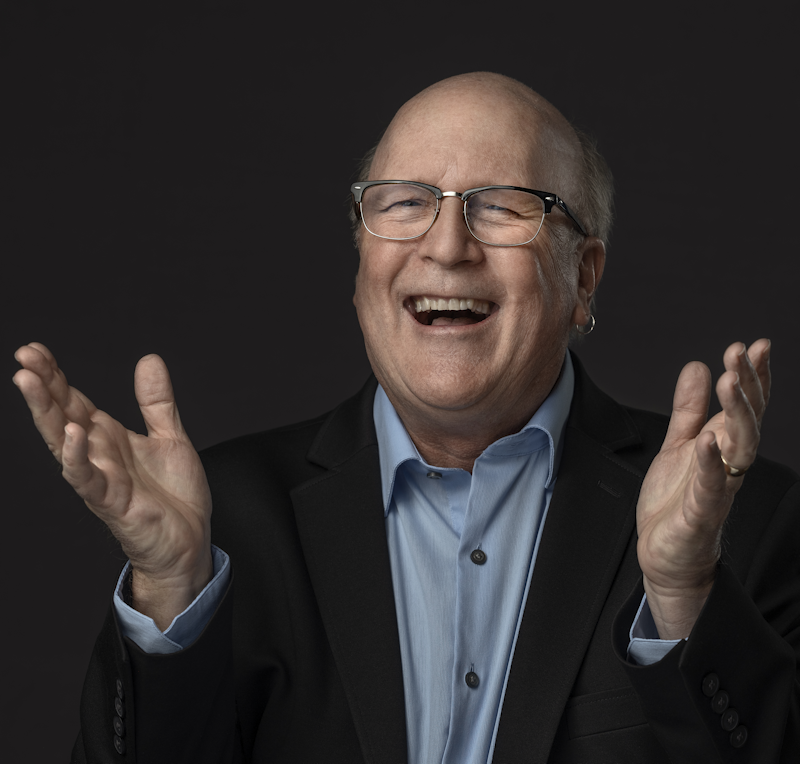
What do you hope children will enjoy learning during this performance?
I want kids and families to fall in love with the people, the sound, and the experience of a symphony concert. That’s it.
In this concert, I include a funny story, interesting characters, and kid-friendly graphics that bridge and support the musical moments. When the orchestra plays, the musicians are the stars. The music, story, graphics and humor are my tools to connect the orchestra and the kids, and light their inquisitive brains on fire for music and their life with music. They will learn about the sections of the orchestra, They will see and hear soloists, sections, idiomatic techniques, and so much more. They will discover how those amazing sounds they have heard in movie scores are actually made by real people. They will be absorbing all that information and storing it because they will be experiencing it with their eyes, ears, bodies and brains. It’s how they learn best.
I want kids to leave and tell their friends how awesome it was. I want them to see the individuals in the orchestra as mega-talented, but very real people, not as motionless cogs behind the black wall of the front row of players. I want them to laugh, say “wow,” and point to individual players and sections and say, “I want to be like them!”
Kids are aspirational – they want to be like somebody else. They want heroes. They don’t want to be the Dallas Cowboys; they want to be Dak Prescott. In the same way, they don’t want to be the Fort Worth Symphony; they want to be Michael Shih, or Pam Adams, or Kyle Sherman, or Deborah Mashburn.
Kids at this age don’t want to be told what they are supposed to learn. They want to discover it themselves. This program is designed to give them a 40 minute discovery journey of sights, sounds, and people that will make them want to come back for more. And, it’s all done with lots of humor, and zero “preachy-teachy” moments.
****end****
If Barney the Dinosaur Were Growing Your Orchestra’s Audience, Here’s What He’d Do.
Kids, Concerts, and Cultivating Crowds
A manifesto for building orchestra audiences
by Bob Singleton
I’m a classically trained composer and producer, who has written for orchestras, recordings, commercials, TV, and movies. My information about kids comes from being privy to research during my years as music director for one of the most popular music-driven properties in the history of kids programming on PBS, Barney the Dinosaur®.
I heard and participated in discussions of research about kids, toddlers through teens, that provide a template to capture and enchant kids and families. I’ve seen that research bear fruit with several projects.
I’m going to share how it will work for the music and people that I love, the symphony orchestra.
A kid goes to his first orchestra concert. As the orchestra takes its first long, quiet pause, the kid turns to his mother and asks, “Why is it called a movement, if they just sit there?”
Orchestras everywhere are trying to capture new audiences, and kids and families are among the most coveted sources for new audiences. Organizations of all kinds that deftly connect with kids and families, know it happens by knowing who kids are, and when and how to capture them. Experienced marketers also know that when they capture a kid at the right age, they are connecting with the whole family’s interests and purchasing power–often for a lifetime.
Paraphrasing a quote attributed to everyone from Oprah Winfrey to Spongebob; after attending an orchestra concert, kids may not remember a note that was played, they may briefly remember something that was said, but they will always remember how they felt. The best organizations make certain that kids feel enchanted by what they experience.
Kids, life, and music
Kids breathe music from birth. Kids connect with music to develop language, structure, intellect, and more. Music, for kids, is at its most captivating when it is connected with human interaction–and music and human interaction is at the core of every live orchestra experience.
The best age to capture kids for the symphony is roughly ages 6 to 10. Kids this age are intellectually and developmentally prepared to be affected by a life-changing experience at the symphony.
At this impressionable age, kids aren’t locked into a musical identity. They are aspirational and seek heroes. They connect with individuals, not institutions. They access information using all their senses and experience life with all senses simultaneously. They are endlessly curious. They want to see and experience. They don’t want you to tell them, they want to discover for themselves. And, they want to laugh. They really want to laugh. A lot.
This age can be summed up in two words: discover, and laugh. Hit the mark on those two concepts with kids this age, and you’ve captured your new audience, and importantly, their families with them.
First impressions
Kids want to have fun, yet orchestras often feel most comfortable dishing out information, not feeding out fun. When that happens, nobody wins. If orchestras offer a serving of uninspiring educational vegetables for a kid’s first experience, they lose their only “first chance” with that kid.
Kids must first be thrilled. Early orchestra experiences should be a 9-year-old’s dream: exciting, filled with age-appropriate sights, sounds, and sensations that make them laugh and want more.
Igor Stravinsky is credited with saying, “I haven’t understood a bar of music in my life, but I have felt it.” Kids are the same. Let kids feel the experience. Don’t explain it to them.
A kids and family concert will be different from a “grown-up’s” concert. Embrace the difference. The virtuoso music of the masters isn’t required in your kids concerts. What’s required is music that creates an extraordinary, kid-capturing multi-sensory experience, full of sights, sounds, and sensations. The music is part of the entire experience, and it should be packed with dynamic fun, delivered with humor and activity. Once kids have their first “wow” experience, they will be ready to explore the depth and range of the orchestra. They will be hooked.
That first experience should not be a quiet classroom in a concert hall. It should look like kids–with wiggles, heads on a swivel, bouncing, and chatter. The object is to channel that kid-energy into a love for the orchestra, not chain it to a seat.
Kids require a multi-sensory experience. Boldly present visuals, seat-shaking sensations, and the full dynamics and textures of the orchestra. Make the most of projection, plus, let them see and connect to your conductor, the musicians, and their instruments. Give them lots of “in-the-seat” opportunities to interact, with applause, shouts, rhythm, and laughter.
A kids and family concert will be free of rules and full of stimulus. It will be kinetic and dynamic; visually, aurally, and experientially. It won’t be a slow dramatic arch of theme, development, and long periods of repose. It will be a series of heroic moments with people, images, sounds, and humor. Kids should leave feeling a sense of “wow,” wanting to tell their friends how it was so cool.
It’s imperative to engage kids in fun and laughter. Laughter is a visceral, whole-body bonding experience for kids. Ignore belly-laughs and fun with kids this age at your peril.
Plan it
When planning your kids and family concert, keep it under 50 minutes, and follow these guidelines:
- Start with a “wow” opening.
- Create kinetic action within the orchestra. Break the wall of the first row of musicians by having sections and soloists frequently stand and sit for action and visibility.
- Showcase individuals, instruments, and dynamics with “heroic moments” that feature soloists and sections.
- Add kid-friendly projections with pictures and little-to-no text.
- Mix music and dialog in alternating, quick doses. Dialog must be age-appropriate and include large amounts of elementary-age humor.
- Include “in-the-seat” interaction–clapping, laughing, cheering, and call-and-response.
- Create concert titles, subjects, ideas, or characters that connect with kids.
- Don’t depend on performing “familiar” concert works. It’s possible that all orchestral repertoire is unfamiliar to your audience. Connect using fun, interesting sounds and textures, and compelling sights.
- Let your audience learn by observation, not by lecture.
- End with a big, noisy, fun, grand finale, and no talking or lecturing. Leave the audience cheering, laughing, and wanting more.
Include pre-and-post concert lobby multi-sensory experiences that connect with the program. Create development opportunities with businesses and organizations that also want to reach kids and families.
Be bold
Go, capture, and build your new audience. Reach out every season. After you “wow” and captivate your new audience of life-long orchestra lovers, the opening joke in this article could be followed with this:
A kid goes to his second orchestra concert. As the orchestra takes its first long, quiet pause, he turns to his mother and says, “I prefer the atonal, aleatoric intricacies of post-modernism.”
OK–maybe not. Wow them first, then take them on a life-journey with the people and music of your orchestra.
***
Bob Singleton is a Grammy® and Dove nominated composer and producer of music for all ages. He has arranged and produced two RIAA Certified Platinum award albums, and had music in the triple Academy Award nominated movie, “In America,” in addition many other projects for network TV and international distribution.
His kids and family concert for symphony orchestra, narrator and projected graphics, “When Instruments Roamed the Earth!®” was premiered by the Fort Worth Symphony Orchestra at Bass Hall in their 2018-2019 season. He can be contacted at bobs@singletonproductions.com.
